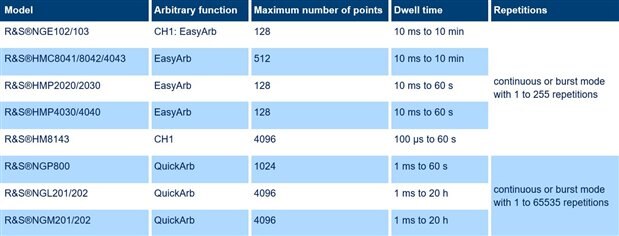Modern circuitries require different voltage and/or current levels in different operating states. For example, when simulating a startup sequence of an embedded system specialized voltage and current profiles synchronized across several channels are required.
What is special about an arbitrary waveform generator function?
R&S power supplies feature a free built-in arbitrary waveform generator. With this function, you can easily generate and customize your voltage and current levels over time as needed in your application.
You can either program a new pattern directly on the instrument, load a .cvs file that can conveniently be compiled, or you can program the points via SCPI. For each step of the pattern, you can set voltage, current, duration and interpolation. The various models have different ranges for programmable voltage, current, dwell time, number of repetitions and number of data points. The following table summarizes these specifications for the R&S power supply portfolio.
What are possible applications?
The arbitrary waveform feature allows you to simulate device behaviors. Often it can even replace basic standalone arbitrary waveform generators. Overall, the versatility of the arbitrary waveform generator makes a wide range of applications possible. Several basic and advanced examples are described below:
1. Square and rectangular waves
Square and rectangular waves are among the most basic patterns. They are described by switching the voltage and current between two fixed levels. Square waves can be used to test the durability of a DC motor or to emulate TTL signals.
2. Ramp
A ramp changes the voltage or current linearly from one value to another. Building the ramp using the arbitrary function makes it possible to ramp-down a channel or to control the current or introduce disturbances during the ramp.
3. Sine waves
Sine waves follow the basic mathematical sin(x) function. The main use case of a sine wave on a power supply is to emulate oscillations, but it can also be employed to drive magnetic coils.
4. Sawtooth waves
Periodically repeated ramp functions result in a sawtooth or triangle pattern. The most common applications are vertical and horizontal deflection signals as they occur when rastering a surface.
5. Pulse or glitch
A pulse is a signal with a given amplitude for a short duration. If the duration is approaching 0, it is called a glitch. These signals can be employed to simulate circuit anomalies in digital designs.
6. Combination
The combination of basic waveforms and/or the arbitrary definition of shapes allows you to adapt the possibilities of the power supply to your specific need. In addition, on models with more than one channel, combinations across channels can be programmed. For example, this can be bit patterns or even slow I/Q data streams.
You can find more information about the built-in arbitrary waveform generator as well as about its applications in this AppCard !







